
Learning the best approaches to pinched nerve treatment is a valuable lesson needed by anyone who has been diagnosed with a compressive neuropathy condition in the spine. A pinched nerve is a diagnostic conclusion which suffers from many myths associated with its symptoms, causes and possible solutions. If you are not 100% sure that your diagnosis is correct, then you owe it to yourself to go back and read much of the material we have already presented in our pinched nerve resource section.
If you have already gone through the process and are fully confident that a neurologist has confirmed a compressive neuropathy issue in your spine, then this article will help to provide the pros and cons of a variety of therapy options you might consider. Always investigate all your options with your doctor before making any final determinations as to the best path for your treatment needs.
Symptomatic Pinched Nerve Treatment
Regardless of the cause of the pinched nerve, so many care providers simply set up a conservative therapy program using one or more symptomatic treatments. This means that nonsurgical methods of care will be utilized, which is a very good thing, but unfortunately, these modalities will do nothing to actually resolve the underlying compressive offender. To put it simply, the cause of the pain will go untreated, while the pain itself becomes the focus of care.
Symptomatic back pain treatment is the rule, rather than the exception, since it is the most profitable path of care. Conservative approaches must be used continuously to remain effective and this amounts to a whole lot of money coming in for the doctor. Best of all, the doctor can always advise an escalation of care to include high priced therapies like spinal decompression or even back surgery at any time down the line.
The good part about symptomatic care is that it allows the patient to avoid back surgery and possibly find adequate relief, although this latter benefit is surely not guaranteed. The negative aspects are many, including a high and ongoing cost factor, possible health consequences from some methods of care and being enslaved in treatment with no hope for a true cure.
Symptomatic care is ill advised for most patients. It is also a topic of great interest for me, since every medical school cautions against it and calls it bad science. Ironically, it is the type of care that the overwhelming majority of doctors provide.
You can explore all your symptomatic pinched nerve treatment options in our resource section dedicated to back pain treatments.
Curative Treatment for a Pinched Nerve
Curative modalities for pinched nerves will seek to actually stop the compression from taking place. In essence, these treatments will find the offending structure placing pressure on the nerves and remove it. Sounds simple right? Well, in theory, maybe, but statistically, curative approaches for pinched nerve care do not offer very promising results.
Curative pinched nerve therapies can be surgical or nonsurgical. Nonsurgical care is usually best represented by spinal decompression. This modern alternative to surgery uses precise and ridiculously expensive machines to slowly traction the spinal bones apart. This can relieve pinched nerve symptoms due to some possible sources, including degenerative disc disease, herniated discs and some types of osteoarthritic activity in the vertebral column.
However, most curative methods of care are surgical and therefore involve many significant risks which need to be weighted against the possible benefits of treatment. Many different procedures may be used to decompress nerves surgically, including discectomy, foraminotomy, laminectomy and other approaches. The proper procedure will depend greatly on the case-specific reason for the compression to exist and the particulars of the patient’s overall condition.
You can learn more about all the operative interventions used to treat pinched nerve in my back surgery resource section.




